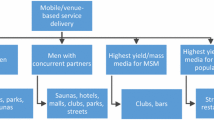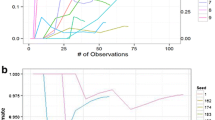Abstract
Men who have sex with men (MSM) are a key population for HIV control and prevention in China. It is difficult to acquire representative samples of this hidden population. Respondent-driven sampling (RDS), based on peer referral, and time-location sampling (TLS) based on random selection of venue-day-time periods, are among the most commonly used sampling methods. However, differences in HIV-related characteristics of MSM recruited by these two methods have not been fully evaluated. We compared sociodemographics, risk behaviors, utilization of HIV-related intervention services, and HIV/syphilis infection rates between samples of 621 RDS MSM and 533 TLS MSM in Shenzhen, China in 2010. We found that the HIV prevalence was comparable in RDS and TLS MSM. TLS recruited larger proportions of more marginalized MSM than RDS: MSM recruited by TLS were older, less educated and more likely to be migrants (without Shenzhen hukou registration), to be non-gay identified and to engage in risky sexual behaviors. On the other hand, MSM recruited by TLS were more likely to have been covered by HIV-related intervention services. To conclude, in Shenzhen, TLS is more effective to reach the marginalized population of MSM. But because TLS can only reach MSM who physically attend venues and HIV-related intervention services are already commonly available at gay venues in Shenzhen, RDS is more informative for allocating prevention efforts than TLS. Furthermore, researchers and public health authorities should take into account the different sample compositions of RDS and TLS and apply sampling methods consistently when evaluating trends over time.
Similar content being viewed by others
References
Baral, S., Trapence, G., Motimedi, F., Umar, E., Iipinge, S., Dausab, F., et al. (2009). HIV prevalence, risks for HIV infection, and human rights among men who have sex with men (MSM) in Malawi, Namibia, and Botswana. PLoS One, 4(3), e4997. doi:10.1371/journal.pone.0004997.
Benoit, E., Pass, M., Randolph, D., Murray, D., & Downing, M. J, Jr. (2012). Reaching and engaging non-gay identified, non-disclosing Black men who have sex with both men and women. Culture Health and Sexuality, 14(9), 975–990. doi:10.1080/13691058.2012.709640.
Berry, M., Wirtz, A. L., Janayeva, A., Ragoza, V., Terlikbayeva, A., Amirov, B., … Beyrer, C. (2012). Risk factors for HIV and unprotected anal intercourse among men who have sex with men (MSM) in Almaty, Kazakhstan. PLoS One, 7(8), e43071. doi:10.1371/journal.pone.0043071.
Chen, L., Feng, T. J., Tan, J. G., Cai, W. D., & Zhang, Y. (2008). Estimate the male homosexual population in Shenzhen by capture-mark-recapture method in 2006. Journal of Tropical Medicine, 8(2), 175–176.
Choi, K. H., Ayala, G., Paul, J., Boylan, R., & Gregorich, S. E. (2013). Social network characteristics and HIV risk among African American, Asian/Pacific Islander, and Latino men who have sex with men. Journal of Acquired Immune Deficiency Syndromes, 64, 496–501. doi:10.1097/QAI.0b013e3182a7ee52.
Chow, E. P., Wilson, D. P., & Zhang, L. (2011). What is the potential for bisexual men in China to act as a bridge of HIV transmission to the female population? Behavioural evidence from a systematic review and meta-analysis. BMC Infectious Diseases, 11, 242. doi:10.1186/1471-2334-11-242.
Dodge, B., Schnarrs, P. W., Goncalves, G., Malebranche, D., Martinez, O., Reece, M., … Fortenberry, J. D. (2012). The significance of privacy and trust in providing health-related services to behaviorally bisexual men in the United States. AIDS Education and Prevention, 24(3), 242–256. doi:10.1521/aeap.2012.24.3.242.
Fan, S., Lu, H. Y., Ma, X. Y., Sun, Y. M., He, X., Li, C. M., … Ruan, Y. H. (2012). Behavioral and serologic survey of men who have sex with men in Beijing, China: Implication for HIV intervention. Aids Patient Care and STDs, 26(3), 148–155. doi:10.1089/apc.2011.0277.
Feng, Y., Wu, Z., & Detels, R. (2010). Evolution of men who have sex with men community and experienced stigma among men who have sex with men in Chengdu, China. Journal of Acquired Immune Deficiency Syndromes, 53(Suppl 1), S98–103. doi:10.1097/QAI.0b013e3181c7df71.
Ferreira, L. O., de Oliveira, E. S., Raymond, H. F., Chen, S. Y., & McFarland, W. (2008). Use of time-location sampling for systematic behavioral surveillance of truck drivers in Brazil. AIDS and Behavior, 12(4 Suppl), S32–S38. doi:10.1007/s10461-008-9386-0.
Guo, Y., Li, X., Fang, X., Lin, X., Song, Y., Jiang, S., et al. (2011). A comparison of four sampling methods among men having sex with men in China: Implications for HIV/STD surveillance and prevention. AIDS Care, 23(11), 1400–1409. doi:10.1080/09540121.2011.565029.
He, N. (2007). Sociodemographic characteristics, sexual behavior, and HIV risks of rural-to-urban migrants in China. BioScience Trends, 1(2), 72–80.
Heckathorn, D. D. (1997). Respondent-driven sampling: A new approach to the study of hidden populations. Social Problems, 44(2), 174–199. doi:10.1525/sp.1997.44.2.03x0221m.
Huan, X., Hao, C., Yan, H., Guan, W., Xu, X., Yang, H., … Lau, J. T. (2013). High prevalence of HIV and syphilis among men who have sex with men recruited by respondent-driven sampling in a city in Eastern China. Asia-Pacific Journal of Public Health. doi:10.1177/1010539513480230.
Johnston, L. G., Sabin, K., Hien, M. T., & Huong, P. T. (2006). Assessment of respondent driven sampling for recruiting female sex workers in two Vietnamese cities: Reaching the unseen sex worker. Journal of Urban Health: Bulletin of the New York Academy of Medicine, 83(6), I16–I28. doi:10.1007/s11524-006-9099-5.
Karon, J. M., & Wejnert, C. (2012). Statistical methods for the analysis of time-location sampling data. Journal of Urban Health, 89(3), 565–586. doi:10.1007/s11524-012-9676-8.
Kendall, C., Kerr, L. R., Gondim, R. C., Werneck, G. L., Macena, R. H., Pontes, M. K., … McFarland, W. (2008). An empirical comparison of respondent-driven sampling, time location sampling, and snowball sampling for behavioral surveillance in men who have sex with men, Fortaleza, Brazil. AIDS Behavior, 12(4 Suppl), S97–S104. doi:10.1007/s10461-008-9390-4.
Ko, N. Y., Koe, S., Lee, H. C., Yen, C. F., Ko, W. C., & Hsu, S. T. (2012). Online sex-seeking, substance use, and risky behaviors in Taiwan: results from the 2010 Asia Internet MSM Sex Survey. Archives of Sexual Behavior, 41(5), 1273–1282. doi:10.1007/s10508-012-9908-8.
McKnight, C., Jarlais, D. D., Bramson, H., Tower, L., Abdul-Quader, A. S., Nemeth, C., et al. (2006). Respondent-driven sampling in a study of drug users in New York City: Notes from the field. Journal of Urban Health, 83(6), I54–I59. doi:10.1007/s11524-006-9102-1.
Paz-Bailey, G., Miller, W., Shiraishi, R. W., Jacobson, J. O., Abimbola, T. O., & Chen, S. Y. (2013). Reaching men who have sex with men: A comparison of respondent-driven sampling and time-location sampling in Guatemala City. AIDS and Behavior, 17, 3081–3090. doi:10.1007/s10461-013-0589-7.
Rudolph, A. E., Fuller, C. M., & Latkin, C. (2013). The importance of measuring and accounting for potential biases in respondent-driven samples. AIDS and Behavior, 17, 2244–2252. doi:10.1007/s10461-013-0451-y.
Shenzhen CDC. (2013). Report of HIV epidemic in Shenzhen. Shenzhen Center for Disease Control and Prevention.
Shenzhen Statistics. (2012). Statistical Yearbook. Shenzhen, China: Bureau of Statistics, Shenzhen, China. Retrieved from http://www.sztj.gov.cn/main/index.shtml.
Tan, J., Cai, R., Lu, Z., Cheng, J., de Vlas, S. J., & Richardus, J. H. (2013). Joint marketing as a framework for targeting men who have sex with men in China: A pilot intervention study. AIDS Education and Prevention, 25(2), 102–111. doi:10.1521/aeap.2013.25.2.102.
Tang, W. M., Huan, X. P., Mahapatra, T., Tang, S. Y., Li, J. J., Yan, H. J., … Detels, R. (2013). Factors associated with unprotected anal intercourse among men who have sex with men: Results from a respondent driven sampling survey in Nanjing, China, 2008. AIDS and Behavior, 17(4), 1415–1422. doi:10.1007/s10461-013-0413-4.
Tsui, H. Y., & Lau, J. T. (2010). Comparison of risk behaviors and socio-cultural profile of men who have sex with men survey respondents recruited via venues and the internet. BMC Public Health, 10, 232. doi:10.1186/1471-2458-10-232.
Wang, L., Norris, J. L., Li, D. M., Guo, W., Ding, Z. W., & Wang, N. (2012). HIV prevalence and influencing factors analysis of sentinel surveillance among men who have sex with men in China, 2003–2011. Chinese Medical Journal, 125(11), 1857–1861.
Wei, C., McFarland, W., Colfax, G. N., Fuqua, V., & Raymond, H. F. (2012). Reaching black men who have sex with men: A comparison between respondent-driven sampling and time-location sampling. Sexually Transmitted Infections, 88(8), 622–626. doi:10.1136/sextrans-2012-050619.
WHO, UNAIDS, & Ministry of Health. (2011). A Joint Assessment Report of HIV/AIDS Prevention, Treatment and Care in China. Beijing: Ministry of Health.
Zhang, B. C., Li, X. F., Shi, T. X., Yang, L. G., & Zhang, J. D. (2002). A primary estimation of the number of population and HIV prevalence in homosexual and bisexual men in China. Chinese Journal for STD/AIDS Prevention and Control, 8, 197–199.
Zhang, D., Bi, P., Lv, F., Tang, H., Zhang, J., & Hiller, J. E. (2007). Internet use and risk behaviours: An online survey of visitors to three gay websites in China. Sexually Transmitted Infections, 83(7), 571–576. doi:10.1136/sti.2007.026138.
Zhang, L., Zhang, D., Yu, B., Wang, S., Liu, Y., Wang, J., … Li, H. (2013). Prevalence of HIV infection and associated risk factors among men who have sex with men (MSM) in Harbin, P. R. China. PLoS One, 8(3), e58440. doi:10.1371/journal.pone.0058440.
Zhang, M., Chu, Z. X., Wang, H. L., Xu, J. J., Lu, C. M., & Shang, H. (2011). A rapidly increasing incidence of HIV and syphilis among men who have sex with men in a major city of China. AIDS Research and Human Retroviruses, 27(11), 1139–1140. doi:10.1089/aid.2010.0356.
Zhao, J., Cai, W. D., Gan, Y. X., Zhang, Y., Yang, Z. R., Cheng, J. Q., … Wang X. R. (2012). A comparison of HIV infection and related risk factors between money boys and noncommercial men who have sex with men in Shenzhen, China. Sexually Transmitted Diseases, 39(12), 942–948. doi:10.1097/OLQ.0b013e31826f356f.
Zhao, J., Chen, L., Cai, W. D., Tan, J. G., Tan, W., Zheng, C. L., … Wang X. R. (2013). HIV infection and sexual behaviors among non-commercial men who have sex with men at different venues. Archives of Sexual Behavior, 43, 801–809. doi:10.1007/s10508-013-0167-0.
Acknowledgments
The first two authors contributed equally to this article. The authors thank all participants, MSM volunteers and peer researchers, and the staff of the HIV control and prevention division in Shenzhen Center for Disease Control and Prevention. This study was partially supported by National Nature Science Foundation of China (30901224 and 81270043), Shenzhen Science Technology Foundation (201202093), and Shenzhen Medical Research Foundation (201302141).
Author information
Authors and Affiliations
Corresponding author
Additional information
Rui Cai and Jin Zhao contributed equally to the manuscript.
Electronic supplementary material
Below is the link to the electronic supplementary material.
Rights and permissions
About this article
Cite this article
Zhao, J., Cai, R., Chen, L. et al. A Comparison Between Respondent-Driven Sampling and Time-Location Sampling Among Men Who Have Sex with Men in Shenzhen, China. Arch Sex Behav 44, 2055–2065 (2015). https://doi.org/10.1007/s10508-014-0350-y
Received:
Revised:
Accepted:
Published:
Issue Date:
DOI: https://doi.org/10.1007/s10508-014-0350-y




